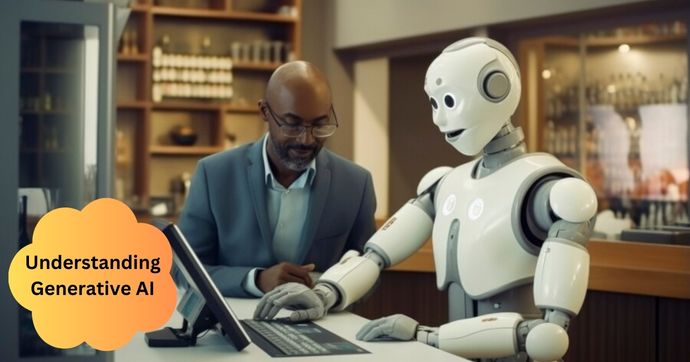Have you ever encountered a chatbot that seemed eerily human-like in its conversation? Or perhaps you’ve stumbled upon an image so realistic, it looked like a photograph? These wonders might be the handiwork of generative AI, a rapidly evolving field of artificial intelligence.
But what exactly is generative AI, and how does it function? Buckle up, because we’re diving into the world of this ingenious technology, exploring its benefits and potential drawbacks in a clear and easy-to-understand way.
What is Generative AI?
Imagine a creative spark meeting a giant digital library. That’s essentially what generative AI is! It utilizes a special type of artificial intelligence called deep learning. Deep learning models are trained on massive amounts of data, like text, images, or even code. By analyzing these patterns, the model learns to not just recognize existing content, but also to generate entirely new things that resemble the data it studied.
Think of it like this: if you showed a generative AI model a collection of cat pictures, it would learn the defining features of a cat – its whiskers, fur, paws, and so on. Then, it could use that knowledge to create brand new images of cats, perhaps even ones in fantastical scenarios!
Think of it like a super-powered copycat. It can mimic the style and format of the data it’s trained on, but with a twist – it creates something completely fresh!
Must Know-: Best Software Development Company in India
How Does it Work?
Generative AI is like a student learning from a huge library. The more information it processes, the better it gets at recognizing patterns and structures. When you give it a prompt, like a sentence or an image, it uses its knowledge to create something new that follows those patterns.
Remember those old, clunky computer programs that required special codes to operate? Generative AI is moving away from that. Now, we can interact with it through user-friendly interfaces, often just by giving simple instructions in plain language.
There are different ways generative AI works, but it often involves something called a neural network. Inspired by the human brain, these networks can learn complex patterns without needing constant human intervention.
History of Generative AI
The idea of intelligent machines has been around for centuries, but generative AI, as we know it today, is a relatively new invention. Key milestones include:
- The 1950s: Alan Turing paves the way for modern AI with his research on machine thinking.
- The 1950s: The invention of neural networks, a crucial building block for generative AI.
- The 2010s: Generative adversarial networks (GANs) emerge, allowing AI to create realistic images, videos, and audio.
- The 2020s: Large language models like ChatGPT take center stage, showcasing the vast potential of generative AI.
The Future of Generative AI
Generative AI is still young, but it’s already making waves in various fields, from creative industries to scientific research. As technology advances, we can expect even more exciting applications to emerge.
Beyond these, generative AI automates tasks and streamlines workflows across industries. As it evolves, even more exciting applications await, shaping the future of how we work, learn, and live! This is just the beginning of a new era of creativity, powered by AI!
The Positive Side of Generative AI: A Boon for Many Fields
The uses of generative AI are numerous and ever-growing. Here are some thrilling ways it’s having a positive effect:
- Boosting Creativity: Generative AI can assist artists, designers, and writers by generating ideas, creating variations of existing works, or even composing music. It can be a powerful tool to spark inspiration and overcome creative roadblocks.
- Revolutionizing Industries: From developing new materials in science to generating realistic simulations for training purposes, generative AI is transforming various sectors. It can even help design drugs or optimize product development.
- Enhancing Daily Life: Imagine having a more engaging and personalized experience with chatbots or AI assistants. Generative AI can make these interactions feel more natural and helpful, improving our everyday tech encounters.
Not All Sunshine and Rainbows: Potential Challenges of Generative AI
While generative AI shows great potential, it’s crucial to recognize the possible challenges it may present.
- Bias and Misinformation: If the training data used for generative AI models is biased, the generated content might reflect those biases as well. This could lead to the spread of misinformation or perpetuate unfair stereotypes.
- The Ethics of Ownership: Who owns the creative rights to something generated by AI? This is a complex question that needs to be addressed as generative AI becomes more sophisticated.
- The Future of Work: As AI becomes more adept at creative tasks, some worry it might replace human jobs. However, generative AI can also be a powerful tool to augment human capabilities and create new work opportunities.
Conclusion
Generative AI is a rapidly evolving field with the potential to revolutionize how we create, interact, and solve problems. However, it’s crucial to be aware of the challenges and ensure responsible development and use of this technology. As we move forward, generative AI can be a powerful tool for progress, but it’s up to us to ensure it benefits all of humanity.
Read More-: 10 Best AI Tools For Every Developers








